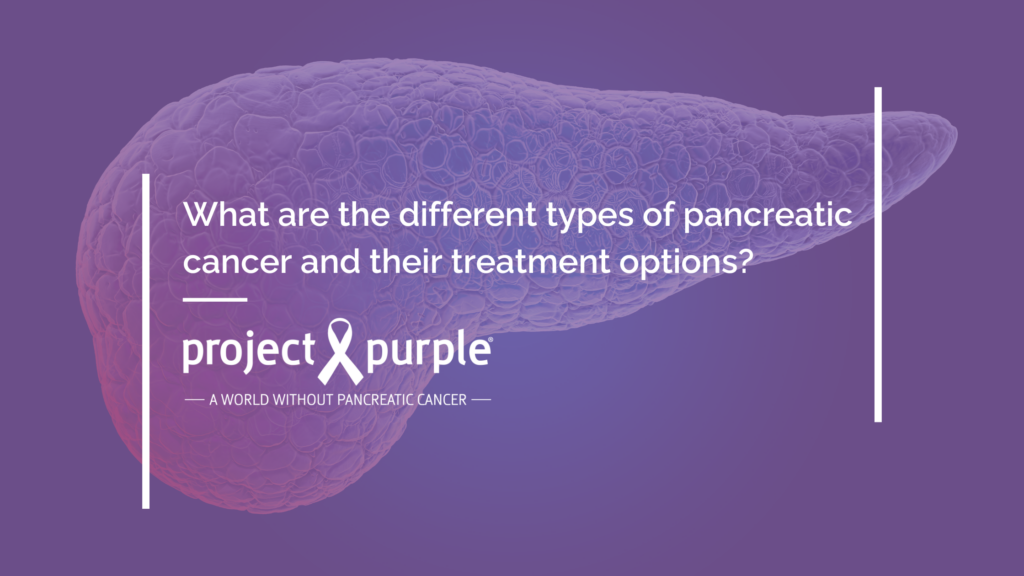
The term pancreatic cancer generally refers to an abnormal cell growth located in the pancreas. However, many people are unaware that pancreatic cancer (PC) comes in many forms and affects the body in different ways. In order to get an understanding of your pancreatic cancer diagnosis, it’s important to know the differences between the types of PC and how they can impact your health. In this article, we will discuss the pancreas and its systems, and then dive into exactly how cancer can affect them.
Get to Know Your Pancreas
In order to understand pancreatic cancer, we first need to look at the body as a whole, and the pancreas’s role within it. The pancreas, according to The National Cancer Institute, is a six-inch gland that sits between the stomach and the spine. Its job in the body is to help with food digestion. It is one organ in the digestive tract, which is your body’s system that converts the food we eat into fuel. The National Cancer Institute states that the pancreas aids the stomach with the breakdown of food by creating juices that help us digest what we eat. It also secretes hormones that help control blood sugar levels and store the energy the body gets from food.
There are multiple parts of the pancreas that all work together to help it do its job. If you look at a diagram, the pancreas is shaped like a sideways pear and is surrounded by several other vital organs and blood vessels. According to The American Cancer Society, the widest end of the pancreas is called the head and is where the stomach connects to the pancreas. The middle section of the pancreas is known as the body, and the narrowest end is called the tail.
As mentioned, the pancreas has two main functions: food digestion and blood sugar regulation. According to Columbia University Medical Center, about 95% of all the tissue in the pancreas is used for food digestion, which is known as the exocrine function or exocrine pancreas. Columbia states that the exocrine tissue produces enzymes or proteins that aid in chemical reactions. Your body creates several different enzymes, however, in the pancreas they are used to break down the chemical bonds of food so that it can be turned into fuel for the body.
Once food enters the stomach, the pancreas and other organs that aid in digestion get to work. According to Columbia, the pancreas secretes enzymes that travel down the pancreatic duct, which runs the length of the pancreas. Columbia University states that the pancreatic duct joins with the common bile duct, which runs throughout the body, and the two ducts merge into the ampulla of Vater. The ampulla of Vater is located in the small intestine, and empties into the part of the organ called the duodenum. The juices then move on to the next part of the digestive process and help to break down carbs, fats, and other types of nutrients.
In addition to the pancreatic duct, the pancreas also contains islet cells, which release hormones into the bloodstream that control blood sugar levels. According to Columbia University, these cells make up less than 5% of all tissue inside the pancreas. These islet cells carry out the second function, or endocrine function, of the pancreas. This function is vital for the body, as maintaining proper blood sugar levels is important for the function of several other major organs, including the brain.
All of these parts of the pancreas and their functionality can be impacted by pancreatic cancer. In the next section, let’s look at how the pancreas is impacted by cancer, and how these different locations can influence your diagnosis.
Cancer and the Pancreas
Cancer, generally speaking, is a disease where abnormal cells in the body divide uncontrollably, which can hurt and kill body tissue. When you have pancreatic cancer, this means that those abnormal cells form in the pancreas. Tumors are simply collections of abnormal cells that have grouped together. While they sometimes can be harmless, or benign, some are not. These are known as malignant tumors.
When you receive a pancreatic cancer diagnosis, you will also likely have received a stage number along with your diagnosis. Stages are numbered between one and four and simply mark how much the cancer/tumors have grown and spread within the body. You may also hear pancreatic cancer categorized by treatment options.
According to Dr. Bret Schipper, Chief of Surgical Oncology for the Hartford HealthCare Cancer Institute, there are three main categories of pancreatic cancer: resectable, borderline resectable, and metastatic.
According to the National Cancer Institute, if a patient has resectable pancreatic cancer, the tumor(s) are contained within the pancreas only. Dr. Schipper states that borderline resectable pancreatic cancer, however, is when the tumor has grown into the areas of the body surrounding the pancreas, including major blood vessels, or surrounding tissue. Metastatic pancreatic cancer, on the other hand, is a form of cancer that has spread into other parts of the body, and therefore the cancer is no longer contained to the pancreatic region.
Types of Pancreatic Cancer
Tumors can form in many places within the pancreas, however, some locations are more common than others. As one may guess based on the section above, most pancreatic cancer starts in the exocrine cells. This is known as either exocrine or nonendocrine pancreatic cancer.
Adenocarcinoma Pancreatic Cancer
Pancreatic adenocarcinoma is the most common type of pancreatic cancer. Adenocarcinoma itself refers to a type of cancer that starts in mucus-producing glands within the body. According to Columbia University, in the pancreas, adenocarcinoma forms in the lining of the pancreatic duct. Because it is so common, most of the time, when a person is reading general information about pancreatic cancer, it is typically referring to information about pancreatic adenocarcinoma.
According to Johns Hopkins Medicine, there are other forms of nonendocrine pancreatic cancer, however, they are extremely rare. These forms include acinar cell carcinoma, squamous cell carcinoma, adenosquamous carcinoma, and colloid carcinoma.
Neuroendocrine Pancreatic Cancer
A patient can also have neuroendocrine PC, though it is much more rare than adenocarcinoma. The cancer develops in the cells of the endocrine system, which makes hormones that control blood pressure. According to John Hopkins, when a tumor forms in a cluster of these endocrine cells, it is known as a neuroendocrine tumor (NET). There are several different types of NETs. According to Johns Hopkins, there are four types of NETs a patient can develop:
- Gastrinoma forms in gastrin-producing cells. Gastrin is a hormone that aids the digestion of food.
- Insulinoma forms in insulin-producing cells. Insulin helps control the amount of sugar, or glucose, in the bloodstream.
- Glucagonoma occurs when an NET forms from glucagon-producing cells. Glucagon also plays a role in the amount of glucose in the bloodstream, and in this case, it increases the amount of glucose present in the body.
- Other types of islet cell tumors make hormones that control the balance of water, sugar, and salt in your body. These types of islet cell tumors are often grouped together because they are treated in much the same way.
Treatment Options For Pancreatic Cancer
There are several different options for patients when it comes to treatment. According to the National Cancer Institute, there are three main types of treatment available to pancreatic cancer patients: chemotherapy, radiation, and surgery.
Chemotherapy, according to the National Cancer Institute, is a cancer treatment that uses medication to stop the growth of cancer cells. The treatment works to kill the cells by stopping them from dividing. It is typically common practice to use a combination of different chemotherapy treatments to attack the cancerous cells, a practice often known as combination chemotherapy.
Dr. Schipper states that Gemcitabine and the combination chemotherapy treatment FOLFIRINOX are two of the most common chemotherapy treatments available to pancreatic cancer patients. The American Cancer Society states that patients may come across other chemotherapy treatments including Gemcitabine, 5-fluorouracil (5-FU), Oxaliplatin, Albumin-bound paclitaxel (Abraxane), Cisplatin, and Irinotecan.
Radiation treatment uses high-energy X-rays to kill cancerous cells by focusing the energy beams on the cancerous region, according to the American Cancer Society. Radiation is often used alongside chemotherapy treatments, which together are sometimes known as chemoradiation or chemoradiotherapy.
There are several different surgeries that pancreatic cancer patients can choose to undergo, given their diagnosis and the type of PC they have. The most common surgery PC patients undergo is a pancreaticoduodenectomy, also known as the Whipple procedure. According to the American Cancer Society, the operation involves removing the head and sometimes the body of the pancreas, as well as certain nearby organs such as the gallbladder or bile duct. This procedure is highly complicated, so at Project Purple, we recommend seeking treatment at a high-volume center, which, according to Duke University Health Center, decreases a patient’s risk of complications.
Patients may also choose to undergo a distal pancreatectomy, which is a procedure that removes the tail of the pancreas, or the tail and part of the body of the pancreas, according to the American Cancer Society. The spleen is also typically removed in this procedure as well, which is known as a splenectomy. Your doctor may also talk to you about a procedure known as a central pancreatectomy, which removes parts of the neck and body of the pancreas. However, most patients are more likely to be recommended for a Whipple procedure or a distal pancreatectomy.
These treatment options are used at varying times throughout a patient’s diagnosis and are commonly used together in a variety of different ways to combat the disease. Typically, according to Dr. Schipper, when a patient is diagnosed with locally advanced or borderline resectable PC, the patient undergoes chemotherapy and/or radiation treatment in order to shrink the tumor first before attempting surgery. Typically, surgery is only performed if the patient responds to previous treatments. Metastatic PC, according to Dr. Schipper, typically is only treated with chemotherapy and radiation, as surgery is not an option for this type of pancreatic cancer.
These treatments are the most commonly used to treat pancreatic cancer, however, sometimes patients seek experimental treatments through clinical trials. Clinical trials are medical research studies designed to test out possible new medications or treatments for specific medical ailments. There are several different types and ways to find clinical trials, so if you are interested in learning more about these studies, please click here to read our blog on the subject.
No matter what form of pancreatic cancer you have, Project Purple is here to help!
Project Purple has several resources for those who are coping with a pancreatic cancer diagnosis. If you need financial assistance, Project Purple can help provide some relief through our Patient Financial Aid program. We assist with medical and everyday living expenses so patients can focus on the fight.
For patients’ comfort and convenience, we also provide nutrition assistance in the form of delicious pre-cooked meals for patients and their families. This program is currently available to pancreatic cancer patients living in MA, NH, RI, CT, VT, ME, NY, NJ, or PA. You can click here to learn more about it.
Lastly, we also have a podcast and blog that details the stories of other patients and survivors. You are not in this fight alone! No matter what your diagnosis is, remember that it does not define you or your life. All it does is give you the best idea of how to move forward.
Recently diagnosed and wondering what to do next? Check out this helpful checklist.



